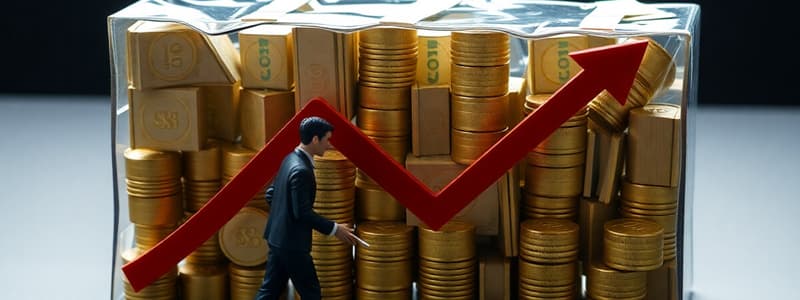Podcast
Questions and Answers
What happens to the aggregate demand (AD) curve when contractionary monetary policy is implemented?
What happens to the aggregate demand (AD) curve when contractionary monetary policy is implemented?
- The AD curve becomes steeper.
- The AD curve shifts to the right.
- The AD curve shifts to the left. (correct)
- The AD curve remains unchanged.
Which monetary policy action is likely to decrease inflation during a demand pool inflation scenario?
Which monetary policy action is likely to decrease inflation during a demand pool inflation scenario?
- Implement fiscal stimulus.
- Increase the cash rate. (correct)
- Lower taxes.
- Decrease the cash rate.
What is the relationship between high inflation and employment levels as indicated by point A in the analysis?
What is the relationship between high inflation and employment levels as indicated by point A in the analysis?
- High inflation reflects only temporary economic growth.
- High inflation occurs alongside labor shortages. (correct)
- Full employment coincides with high inflation.
- Labor shortages lead to decreased GDP.
How does an increase in the interest rate affect expenditure and aggregate demand?
How does an increase in the interest rate affect expenditure and aggregate demand?
What is the primary goal of the Reserve Bank when implementing contractionary monetary policy?
What is the primary goal of the Reserve Bank when implementing contractionary monetary policy?
What impact does a shift to the left of the AD curve have on the economy?
What impact does a shift to the left of the AD curve have on the economy?
In the context of demand pool inflation, what is a potential consequence of increased economic activity?
In the context of demand pool inflation, what is a potential consequence of increased economic activity?
Which of the following accurately describes the economic condition at point A regarding real GDP?
Which of the following accurately describes the economic condition at point A regarding real GDP?
What is the impact on real GDP when consumer confidence falls and the economy is at point eight?
What is the impact on real GDP when consumer confidence falls and the economy is at point eight?
How does a decrease in price level at point eight affect the unemployment rate?
How does a decrease in price level at point eight affect the unemployment rate?
Why does the economy move to point eight when consumer confidence falls?
Why does the economy move to point eight when consumer confidence falls?
What does it mean for the economy when real GDP is below full employment GDP?
What does it mean for the economy when real GDP is below full employment GDP?
What would the Reserve Bank likely consider doing in response to rising unemployment due to decreased real GDP?
What would the Reserve Bank likely consider doing in response to rising unemployment due to decreased real GDP?
What happens to aggregate demand when the economy moves from long-run equilibrium due to a loss in consumer confidence?
What happens to aggregate demand when the economy moves from long-run equilibrium due to a loss in consumer confidence?
How is the short run equilibrium at point eight characterized?
How is the short run equilibrium at point eight characterized?
What differentiates the current economic situation from an expansionary policy?
What differentiates the current economic situation from an expansionary policy?
What happens to aggregate demand (AD) when the government increases spending?
What happens to aggregate demand (AD) when the government increases spending?
How can transfer payments affect consumer spending in an economy?
How can transfer payments affect consumer spending in an economy?
What would likely occur in an economy if the AD shifts from point A back to point Z?
What would likely occur in an economy if the AD shifts from point A back to point Z?
Which policy is implemented to counteract a recession by shifting the AD curve to the right?
Which policy is implemented to counteract a recession by shifting the AD curve to the right?
In the context of economic policy, what is the difference between monetary policy and fiscal policy?
In the context of economic policy, what is the difference between monetary policy and fiscal policy?
What effect does a drop in tax rates have on the economy?
What effect does a drop in tax rates have on the economy?
During which phase of the economic cycle is the need for expansionary policy most pronounced?
During which phase of the economic cycle is the need for expansionary policy most pronounced?
If an economy is at point A indicating low economic activity, which of the following actions would be most appropriate?
If an economy is at point A indicating low economic activity, which of the following actions would be most appropriate?
Flashcards are hidden until you start studying
Study Notes
Demand Pool Inflation
- Demand-pull inflation is characterized by a shift in the aggregate demand curve to the right, leading to an increase in overall price levels.
- This inflation can occur during times of high consumer confidence and spending.
- The Reserve Bank's response to demand-pull inflation is contractionary monetary policy, which aims to decrease aggregate demand and control inflation.
- Contractionary monetary policy involves raising interest rates, decreasing investment (I) and net exports (NX), and shifting the AD curve back to the left. This, in turn, reduces inflation and brings the economy back to full employment.
Falling Consumer Confidence
- Falling consumer confidence can lead to a decrease in aggregate demand, shifting the AD curve to the left.
- A decline in consumer confidence results in a decrease in consumption (C), moving the economy from a long-run equilibrium to a short-run equilibrium.
- The result is a lower overall price level and a reduction in real GDP.
- The economy enters a recession with a real GDP less than full employment GDP.
- Unemployment increases during a recession as businesses produce less.
Expansionary Fiscal Policy
- Expansionary fiscal policy is used to address a recession and increase aggregate demand.
- This policy involves increasing government spending, such as infrastructure projects and transfer payments.
- Transfer payments, such as job seeker and job keeper payments, directly increase household income, boosting consumption.
- Lowering tax rates also encourages spending by increasing disposable income.
- Overall, these actions aim to stimulate economic activity, increase prices, and shift the AD curve to the right, ultimately leading to full employment.
Studying That Suits You
Use AI to generate personalized quizzes and flashcards to suit your learning preferences.




